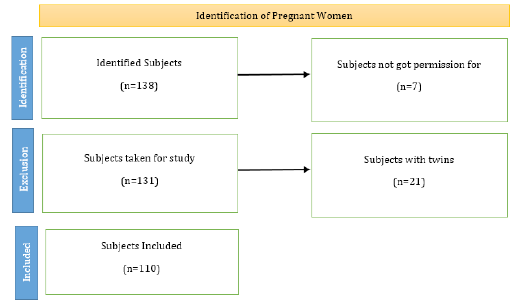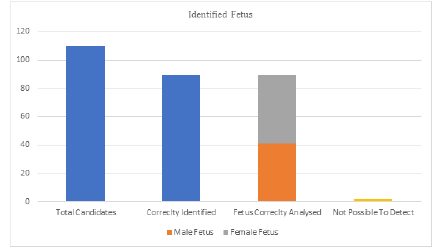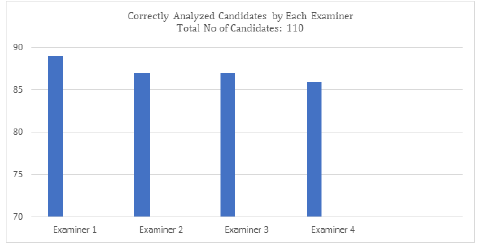Short Communication 
 Creative Commons, CC-BY
Creative Commons, CC-BY
Determination of Fetal Sex from Maternal Pulse Intensity
*Corresponding author:Mahesh Prasanth, Medical University of Gdansk, Poland.
Received:April 06, 2023; Published:April 25, 2023
DOI: 10.34297/AJBSR.2023.18.002499
Abstract
Aim: Determination of fetal gender by palpating the intensity of the maternal pulse on the right and left 5th finger, based on the
Ayurvedic principle that there is a ‘nadi’ (a pathway or channel in the human body) connecting the pregnancy and the 5th finger.
Methods: 130 pregnant women from the Obstetrics Pathology Department-UCK, Gdansk, Poland were included in the study. Twin
pregnancies were excluded. The intensity of pulse on the right 5th finger was palpated followed by palpation of the left 5th finger.
The intensity of the pulse on both fingers was analyzed and the side with the higher intensity of the pulse was determined. The
gender was noted based on the side of higher intensity and the gender was then confirmed by the candidates themselves as well as
by ultrasound. If the palpated pulse on the 5th finger was higher on the right side the conceived fetus was a male and if the intensity
was higher on the left 5th finger, the conceived fetus was a female.
Results: Out of all the candidates (n=138), no permission was granted from few (n=7) and twin pregnancies (n=21) were excluded.
Out of 110 candidates the readings of (n=89), 80.9% were correct. Readings of (n=21), 19% were incorrect out of which in candidates
(n=2), it was not possible to analyze the result as it was difficult to palpate the pulse.
Conclusion: This study showcased a novel approach to fetal sex determination in Western Medicine outside the normal method of
fetal ultrasound. Implementation of this principle showed higher detection rates (80.9%) as compared to a method of determining
fetal gender by fetal heart rate or by a guess (50%). A cost effective, easy to use and time-saving method, not requiring any prerequisites
(can be done by anyone irrespectively) The principles of this study can be a new opening in the field of obstetrics for an
efficient determination of fetal gender especially in low-resource countries.
Keywords: Pregnancy; Gender; Fetus; Pulse intensity; 5th finger; Palpation
Introduction
The fetal sex being one of the curious factors for parents on one hand and a medically important issue for diagnosis of diseases like genetic disorders. There are other methods to determine the fetal sex, the most common and most accurate so far being ultrasound. However, Ultrasound is not cost-effective. The purpose of this new study was to determine the fetal sex through a different method, a procedure which is time saving and a cost-efficient way to find the fetal sex. The study was based on an ancient Indian Ayurvedic principle that there is a ‘nadi’ (a pathway or channel in the human body) connecting the 5th finger to the pregnancy, and it changes in accordance to pregnancy with the pulse on the 5th fingers becoming more prominent when pregnant as compared to non-pregnant state. Using ultrasound needs earlier preparation, funds and specialized knowledge. The method of pulse measurement to determine the fetal gender can be performed by any medical personnel or laymen and requires no prior preparation.
Methods and Materials
Candidates: 130 pregnant women were considered for the study.
Inclusion Criteria:
Consent
• >18 years of age
• singleton pregnancy
gestational age between 20 - 40 weeks
Exclusion Criteria:
No consent
Twin Pregnancy
< 18 years of age
Ethical approval was granted for this study by the hospital authority.
The fetal sex was estimated through palpating the pulse on the medial aspect of the 5th finger (little finger) of both the right and the left hands. First the heart rate of each pregnant women was measured using a pulse oximeter, to find any relation between the heart rate and the gender which later proved to be insignificant. Each candidate was made to sit up and the hands were held on the level of the heart with arms straight to palpate the pulse on both digits. The pulse on both the right and left digits were palpated using investigator’s right index and right middle fingers to keep uniformity. The pulse was palpated by only applying a slight pressure on the medial side of the 5th Finger (phalanx).
In each pregnant candidate, the intensity of pulse was checked on the right 5th finger by palpating on the medial aspect of the 5th finger. The same was repeated for the left 5th finger and the intensity of the pulse on both the fingers was compared. The comparison was based on the results from palpation of the pulse, which helped in determining if the fetal sex was of a male or female. This was also confirmed by the candidate themselves by enquiring about the gender of the fetus and checking the results with ultrasound. The result was based on the subjective opinion of the examiner as the principle was not to use any equipment for the study.
To exclude bias 4 different people palpated the intensity of the pulse, this included people who had previous experience as well as those who did not have any experience in pulse reading ((Figure 1-3).
Results
Pregnant women (n-138) were selected for the study. No permission for the study was granted from seven (n=7) candidates. Out of the 131 candidates, (n=21) were twins who were excluded from the study. Finally (n-110) candidates were included. In the study a total of (n=89) readings, 80.9% were analyzed correctly, out of which we identified male fetus (n=41), 46% and female fetus (n=48), 53.9%. (n=21), 19% had incorrect readings out of which readings from (n=2) were not possible to palpate [1-4].
Discussion
We found a correlation between pulse intensity on the 5th finger and the fetal gender. I pregnant with a male fetus the intensity of pulse was felt stronger on the right 5th finger and for female fetus, it was stronger on the left 5th finger. This might be due to the presence of a correlation between pregnancy and the 5th finger, which in the Ayurvedic science refers to as a ‘nadi’. The exact mechanism to this connection and how the change in fetus changes the intensity of the pulse is still not known but it can be understood that it might be due to the difference in different aspects of circulatory system present in a pregnant women, such as increased values of viscosity of blood, heart rate, cardiac output, cardiac load, plasma volume and red cell mass. It can also be due to a difference in the placenta which changes the intensity of pulse on both the right and left sides depending on the gender of the fetus.
The findings of the study are novel as it is the first to show that such a difference between intensity of pulse is present in both the right and left 5th fingers of the body of the pregnant women. This method can be used to determine the gender of the fetus without the use of any devices. The study having an accuracy of 80.9% does have limitations. The method of pulse palpation is operator dependent as it depends on the sensory aspect of an individual, as it was a subjective evaluation. Secondly the state of the mind of the pregnant women, the role of hormones in the body, if the women was at rest or at any activity just before the moment of taking the pulse would have impacted the reading, which was not taken into consideration in this study. Perhaps palpating the pulse in the right and left sides simultaneously would have been better to easy compare the intensities rather than palpating each side separately and then comparing. This study, even though with the limitations, is a very unique method that can be used to determine the gender of the fetus. In a place of absence of ultrasound or experienced technicians this method is a highly effective method to determine gender. The study can also help laymen and parents who are curious about the gender of their fetus. This study thus is a new and efficient method with a greater probability to find the gender as compared to other studies based on heart rate and guessing. Plans on extending the scope of study to further investigate the real physiology of the between the pregnancy and the 5th finger is being done. Further plans to develop equipment to measure the intensity of the pulse to make the readings more accurate are also underway.
Conclusion
The aim was to find the gender of the fetus in pregnant women using the intensity of pulse on the 5th finger based on an ancient Ayurvedic principle of a “nadi”, a connection between the pregnancy and the 5th finger. It brings out a new method in the field of obstetrics in easy gender estimation, bringing out a time-efficient and easy to apply procedure. This method provides an easy way to determine fetal sex without any prerequisites and technical knowledge. This process could be used in an out-patient setting or in case of lack of scanning equipment, which could later be confirmed by other imaging studies.
Acknowledgments
Supervisor: Dr. Przemyslaw Adamski, Department of Obstetrics, Medical University of Gdansk
Reading Pulse and Helping in Conducting the Experiment:
Geevan Joe Baby, Student, Medical University of Gdansk
Mallika Abhishek Wagle, Student, Medical University of Gdansk
Shreya Neelakandhan Namboodiri, Student, Medical University of Gdansk
Conflict of Interest
No conflict of interest to declare.
References
- Mabie WC, DiSessa TG, Crocker LG, Sibai BM, Arheart KL (1994) A longitudinal study of cardiac output in normal human pregnancy. Am J Obstet Gynecol.
- von Tempelhoff GF, Velten E, Yilmaz A, Hommel G, Heilmann L, et al. (2009) Blood rheology at term in normal pregnancy and in patients with adverse outcome events. Clin Hemorheol Microcirc.
- Chung E, Leinwand LA (2014) Pregnancy as a cardiac stress model. Cardiovasc Res.
- Mielke G, Kiesel L, Backsch C, Erz W, Gonser M (1998) Fetal sex determination by high resolution ultrasound in early pregnancy. Eur J Ultrasound.






 We use cookies to ensure you get the best experience on our website.
We use cookies to ensure you get the best experience on our website.